Bucket-Wheel Excavators
Thursday, 19th April 2007 by James Turnbull
Continuing this week's theme of mining, today we're visiting Germany's lignite mining area to find some of the largest land vehicles on Earth!
Lignite (or "brown coal") is found in 3 nearby open cast mines in the Rhineland; Hambach, Bergheim and Garzweiler. Collectively they extract over 100 million tons of lignite every year. Extracting such massive amounts of coal requires massive machines -- hence the development of these descriptively named "Bucket-Wheel Excavators".
Their operation is simple; a large rotating wheel has numerous buckets around the rim - which scoop up the lignite (or soil), and then drop it onto a conveyer belt which runs along to the centre of the machine. A typical Bucket-Wheel Excavator could extract the area of a football field, 30m deep, in a single day's work.
Although the current World record for "largest land vehicle" is held by the RB293 bucket wheel excavator, the former title holder's story is much more interesting.
The story goes that Bagger 288 was the reigning champ in the large vehicle stakes, and operated at the most southerly Mine, Hambach. Here Bagger 288 worked away, happily removing the soil which covered the lignite, until 2001 when it had exposed all the coal and was to be re-located to the Garzweiler mine to the North.
However, rather than dismantling the $100 million machine and moving it in pieces, it was deemed cheaper to just drive the 200m long, 100m tall vehicle, 22 kilometres up the road to its new home!
Unfortunately that route happened to cross Autobahn 61, the River Erft, a railroad line and several roads... The whole process cost the equivalent of $10 million and took three weeks! This absolutely incredible photo taken during the operation gives you pretty good idea of Bagger 288's scale.
More pictures here and here. Wikipedia links for Bucket-Wheel Excavator & Bagger 288.
Thanks to Stefan, Graeme Wilkinson, Paul Burkitt-Gray, Chris, Darby & many other people!
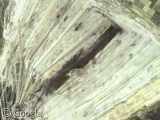

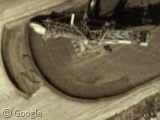
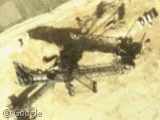
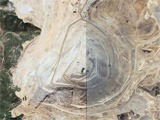
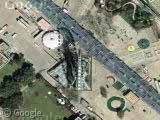
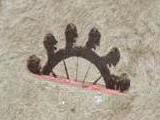
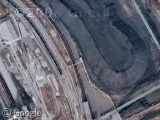
Some time ago, I watched an interesting documentary on German television (I’m German, so that kinda makes sense, doesn’t it?). They showed how such a bagger is dismantled: they use explosives! It’s a kind of cutting explosive that is also used to destroy buildings in narrow spaces, because it cuts the wall (or whatever it is attached to) in half instead of blowing the whole thing to pieces. So, they “cut” the bagger into a few large pieces and then dismantle the pieces. That’s a lot of work!
There is a huge open mine in Krivoy Rog (or Kryvyi Rih, transliterated from the Ukraine instead of from the Russian) at View Placemark I’ve been there and seen it. Amazing. And the air and how your lungs feel testifies to the generations of mining going on.
Sorry. Bleh.
View Placemark (47.926149,33.378224)
Maybe: http://tinyurl.com/yuqeod
Hey – no such thing as a coincedence! You dont have watch Discovery channel for too long before you come across a show called ‘Massive Machines” or ‘Enormous Erections” or something. Anyway this particular mine was on a programme just last night and i was thinking “I’ll have a look for that mine tomorrow on GE cos it cant be too hard to miss!” Well – youve saved me the job! I think i said this before but you can have fun by zooming out and counting how many clicks it takes before you cant see this mine any more. This place is HHHHHHUUUUUUUUGGGGGGEEEEE!
There is a lignite mine off of I-45 in Texas: View Placemark
You can read more about it: http://www.mii.org/txu/TXUAward.html
Not to say that this crane is not huge… but us Canadians have one too… so big in fact, that you can see a pick up truck just to the side of the crane for scale.
https://www.googlesightseeing.com/maps?p=&c=&t=k&hl=en&ll=53.494109,-114.573476&z=17
This just just south of a place marker called Wabamun Lake. It is an open pit mine. I seen this place in 1977 and it made an impression on me then. Still does to this day…
Yeah, this thing is almost as big as the xbox.
This are two other Bagger F60 in a brown coal mine in germany. They are around 500m long. View Placemark (51.586323,13.7778) View Placemark (51.591962,14.258602)
Here is the link to some photos of this Giant Digging Machine :
http://funzu.com/index.php?option=com_content&task=view&id=229&Itemid=26